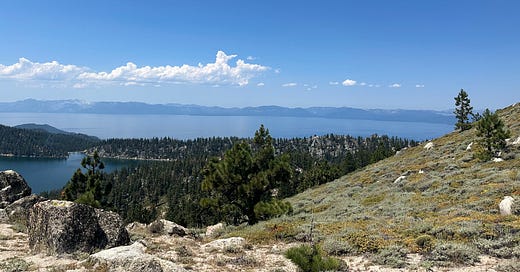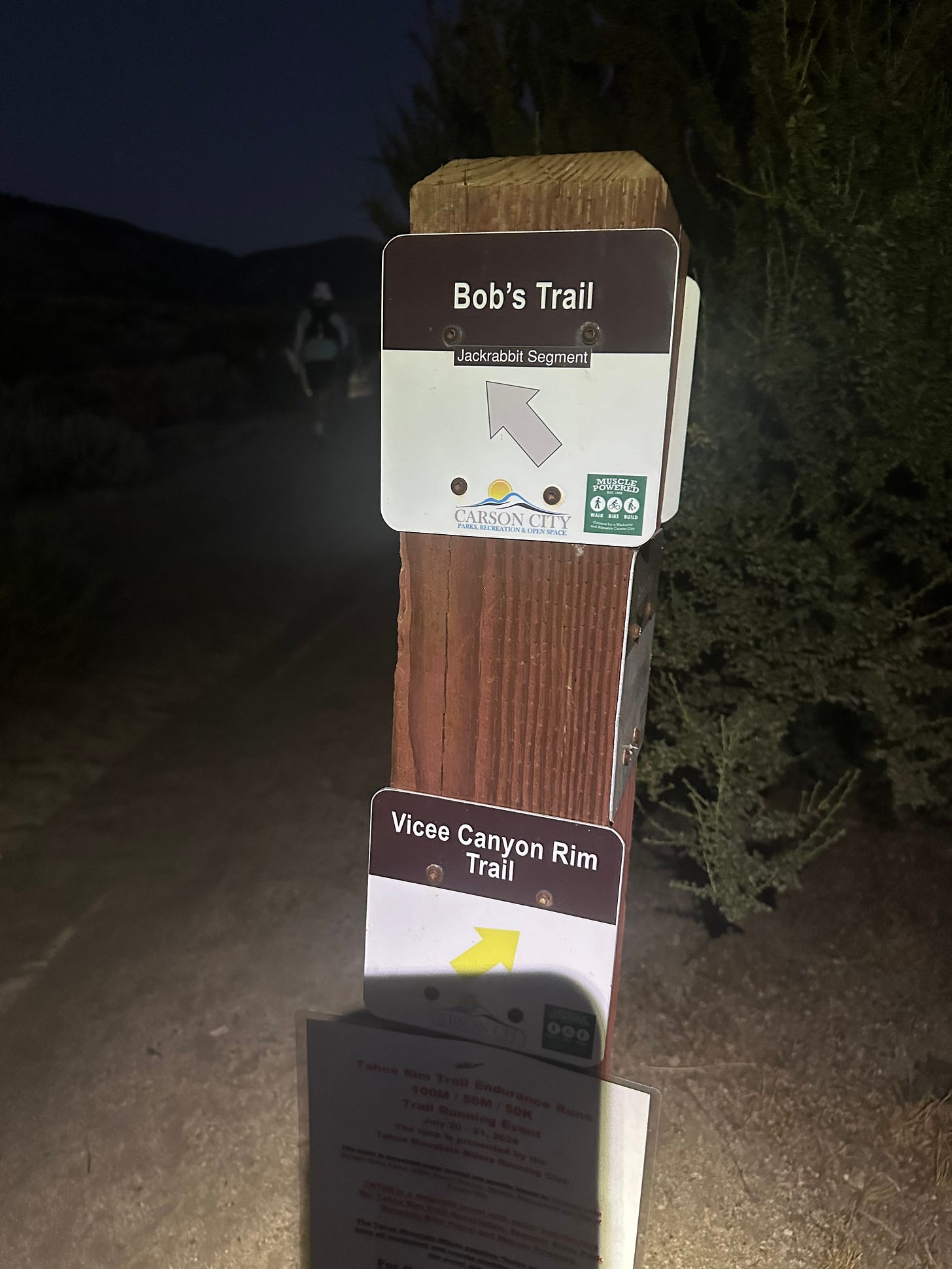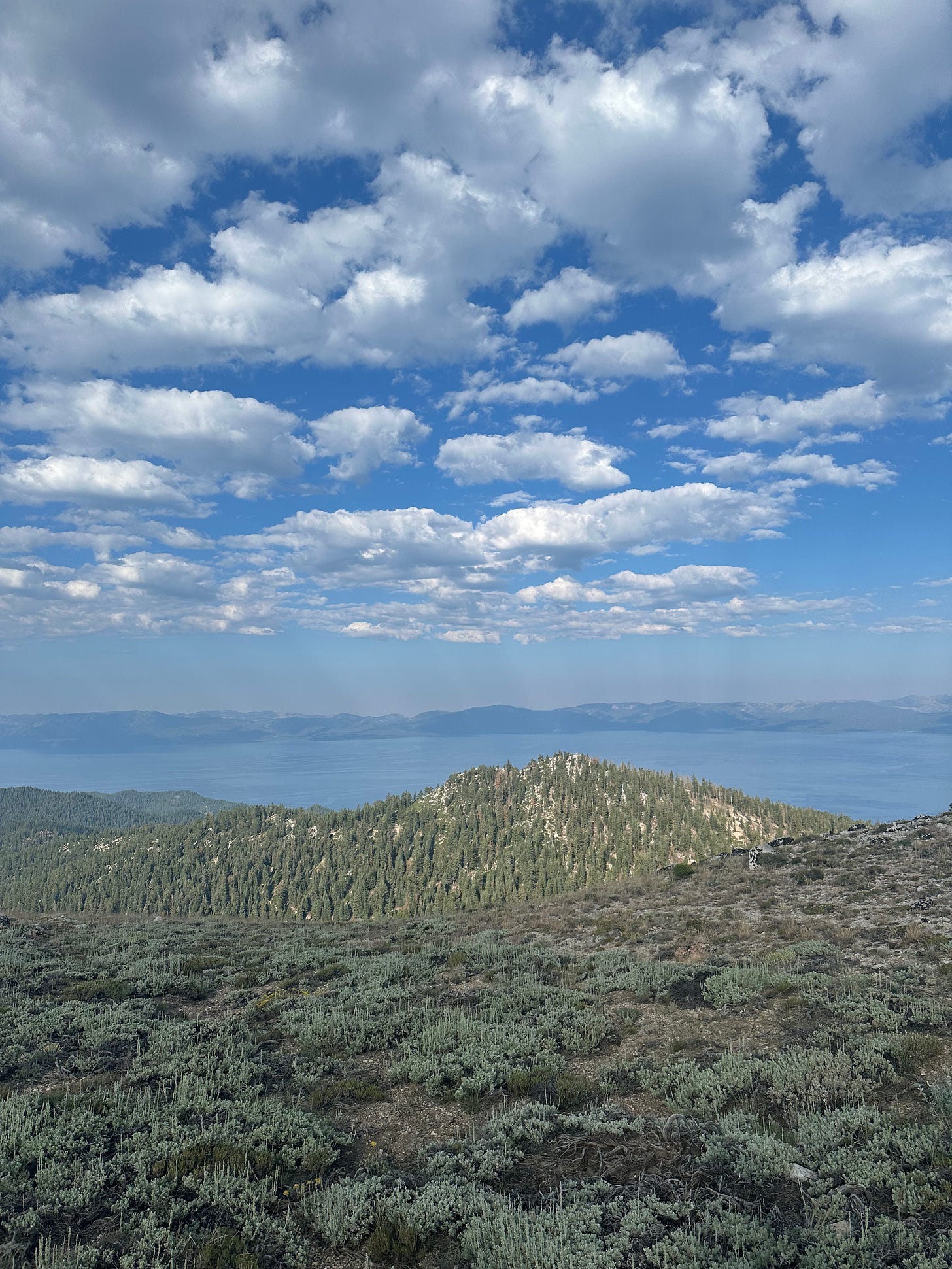Tahoe Rim Trail Endurance Run 100 Mile Requisite Post (Part I)
The First 5 of the Not-Even-Top Ten List
It’s been a long-standing strategy of mine in writing and in presentation to use lists to help me, especially when I’m stuck.
“The Top 5 Tools for Giving Easy and Effective Feedback” for an EdTech Conference
“The Top 10 Things to Know about Me” as my brand ambassador bio for Beth Millner Jewelry
In this case, I’m stuck because I’m so thoroughly overwhelmed. Where do I even begin? The thought of stringing together my thoughts on the Tahoe Rim Trail Endurance Run 100 mile race, (aka 35.5 hours that changed my life forever) seems (a) impossible and (b) so long that no one would want to read it.
When I feel back on my “list” method, I got anxious trying just to narrow down what the top moments of my race would even be.
But I need to write this down; I need to get it out of my system. So I’ve decided that I will use a list, but it will just be 10 things that I remember, in no order. And maybe these won’t even be the top ten things because I’m not going to let myself give it that kind of energy.
So here it is, my “Not Even Top Ten Things about the Tahoe Rim Trail Endurance Run 100 Mile Race”
I cried when I got to the top of Snow Valley Peak (the first time).
I had the race broken down into 20 segments. These segments just represented one aid station to the next and ranged from 2 to 10.5 miles. The first two segments had me stressing for MONTHS. I looked at the elevation profile map rising from over 5000 ft above see level to somewhere just around or above 9000 ft above sea level in just over 9 miles. I read about the many people who failed to finish the race due to elevation sickness. I tried brisk walks on the treadmill with the incline maxed out. I knew that it would be very difficult, but I was determined to take it smart and slow. One foot in front of the other. I stopped to take pictures of the sun rising over Lake Washoe and the Eastern Sierra Mountains to the east. I sent a picture of Bob’s trail to my step dad. I tried to breathe deeply, trust my body and just soak it all in. It was incredibly steep, as advertised, but gradually, I made it to the first aid station and then, with the sun fully shining in a cloudless sky, I saw the aid station at Snow Valley Peak come into view and broke into tears. The aid station workers cheered, then, noticing my tears, asked if I was okay. Between giggles I managed to get out, “YES! I just didn’t know if I was going to make it this far!” I grabbed some bacon, mini pancakes and watermelon and stepped out to the most incredible view of Lake Tahoe.
I had Taylor Swift’s “How Did It End?” in my head for most of the race.
I started out the race without headphones at all, a part of my mission to soak in every moment of the race; content at the start of the race to hear the other racers’ muffled conversations or nervous breathing. It hit me somewhere around mile 10 that the song I had recently been practicing on the piano was playing on a loop in my head. I tried my best to replace it (usually if I just concentrate hard enough, I can change the tune in my head like I do on Spotify), but I just couldn’t shake it. By the time I realized it wasn’t going anywhere without some serious help, my phone was dead and I wouldn’t see Colby until after sunrise. I was on my own for at least the next 12 hours.
When at last I saw him again at about 73 miles in, he paced me for a bit, so I had some conversation to keep me distracted. When I got to 80 miles, I pulled out the playlists to get me home. When I got to the very last aid station with just over 7 miles to go, I turned on my "Ogma Hits”, which is basically every song that the band Pinter-Whitnick (a duo that covers 80s ands 90s hits) played one night when we were out at Ogma Brewing in downtown Jackson. I careened down the mountain to songs like “Jump Around” by House of Pain and “867-5309/Jenny” by Tommy Tutone. I will forever associate Boston’s “More Than a Feeling” and Eddie Money’s “Take Me Home Tonight” with my chaotic and desperate push to the finish line.
Buying and bringing hiking poles was one of the best decisions I’ve ever made.
One of the lowest parts of the race (mentally and physically) for me was coming in and out of the Diamond Peak aid station the first time, so miles 35-45. Approaching the aid station, it occurred to me just how little of the race I had actually done and how very long it had taken to do it. I got a little bit of the wind back in my sails seeing Colby at the aid station. I changed my shoes (which turned out to be totally unnecessary…unlike Michigan, the air is so dry, that any moisture at all evaporates instantly. Instead of having soaking wet feet, I was just really dirty from the copious dust on the trail. The Golden Girls on my gaiters weren’t even visible at that point). I figured that I was experiencing what I knew I would face: a tough stretch. And I had prepared myself for this. My mantras were “I trust my body” and “I will show up for myself when it is hard.”
Coming out of the aid station, however, I faced a 1500 foot climb over 2 miles. The steepness was hard to process even with it right there in front of my face. To top it all off, it was mid-afternoon and exposed on the mountain. The sun beating down was brutal and I couldn’t move fast with the grade. To top it all off, I was vomiting explosively, emptying my stomach of all the precious calories I had been trying to fuel myself with up to this point. On that steep hill with my confidence and my stomach in shambles, I coaxed myself up just 20 steps at a time, each interval feeling like a part of me was giving up. I would count my sorry self up 20 steps, then lean heavily on my poles to rest and recover. 20 steps up. Rest. Recover. Again. Again. Again. I fought back tears each time I looked up to see that I had made what seemed like zero progress. But I just kept going. One step at a time, those poles with me for each one; helping me push with my arms as well as my quads and glutes, steadying me when I felt unstable, and sturdily bearing my weight when I needed to recover. Even when I made it to the top and turned to the next section, I was so dizzy and exhausted, and my stomach was in such bad shape, I honestly didn’t see any way that I was going to make it out of this. I really thought it was the beginning of the end for me.
Later, towards the end of the race, I would be so thankful for my poles once again. My quads shot, chasing the race cutoff, I felt like I was more haphazardly throwing (yeeting) myself down the trail than doing anything remotely resembling running. Each time I stumbled, I caught myself from going down completely with a pole. It’s a miracle I didn’t fall more than just the one time, landing hard on my shoulder and eating a mouthful of dust. Thanks to my poles, I arrived at the finish line with some scratches, but no real harm done.
I don’t have a picture of the best view I saw on the course.
A huge part of the reason I picked this race for my first 100 miler was because I was excited to explore the Tahoe area. I figured if I was going to be out in the woods running for an extended period of time, I would like it to be somewhere that I could look around and be absolutely stupefied with the beauty I saw. That worked to an extent. The mountains and Lake Tahoe were incredible. In the back country I was surrounded by dense conifer forests and boulders the size of buildings. Sadly, I would say the novelty wore off about 40 miles into the race for me, probably because of the fight I was putting up just to move forward. I went from looking around me in amazement (Trees! Mountains! Lake!) to plodding forward resolutely, just trying to make sure I didn’t fall down. After sunset, I was able to somewhat collect myself. As the air cooled and the silence of the forest descended upon me, I gained a sense of peace and focused on getting myself back together. At Hobart Aid Station, I was finally able to get some calories down again in the form of some warm broth with noodles, and this powered me back up the loop in the dead of night. I was hesitant, because I had heard from so many runners that *this* is the most challenging part of the race and I had already been putting up such a fight to this point. But, to my astonishment, I seemed to gain confidence and momentum in the dark. I felt the weight of the woodsy quiet settle in my muscles and bones. By the time I emerged high up on the mountain, I gasped at an enormous, full, orange moon dead center over Lake Tahoe, generously reflected by the still water. I attempted in futility to take pictures, but none of them could come close to capturing the majesty of this view. Those of you who know me also know that I love the moon and stars. I’ve never seen anything like this in my life. I couldn’t capture it in a picture and I can’t describe it in words, but I will never forget it and the nearly imperceptible shift in my race it coincided with. The top of Snow Valley Peak and the ridge line above Marlette Lake were breathtaking, but I’m not sure anything in my life will ever top that full moon above the lake in the dead of night.
In the end, the only person I could really trust was myself (this sounds cynical but I really mean it as a positive thing; I just can’t figure out how to give this a more accurate title and now this is just long and ridiculous).
One of the lowest parts, mentally, of my race was in the second to last segment, consisting of approximately miles 83-93. According to the race director, pre-race meeting and topographic maps, this was a largely runnable, downhill segment. To my immense disappointment, however, it started out with about a three mile climb. I had to have a serious pep talk with myself and put my big girl pants on to accept that while I thought I would be effortlessly gliding downhill, the truth of the matter was I would have to keep moving as fast as I could no matter what I expected.
After what seemed like an interminably long and hot stretch, I ran almost smack into a medic on the trail with a bag full of ice. Apparently, many people were struggling mightily in the heat (understandable), so he had hiked up the trail from the aid station to make sure people were stocked up with ice. He stuffed ice in and around my vest, then told me I had only two miles to the next aid station; only 9 miles left in the entire race. My spirit surged as I pressed on! I was 91 miles in! After an hour and a half, however, I still hadn’t reached the aid station. I felt misled, defeated, hopeless, and exhausted. Every time I turned through a switchback, I thought that the aid station must be right there, only to sink deeper into despair each time it failed to materialize. I was running out of energy and time. I was angry to have my hopes dashed so cruelly. By the time I reached the last aid station, I was at my absolute lowest, convinced I wouldn’t make it to the finish line on at all, let alone on time.
When I took off from this final aid station, I was hoping to use some of the runners in front of me to guide my pace. I figured that they had to be aware of the time crunch we were under, especially those with pacers. It stood to reason that if I was able to keep up with them, I might have a chance to make it. Shockingly, I found myself catching up to these runners only to find they looked absolutely terrible: vomiting on the side of the trail, crying, sitting down with their heads between their knees as their pacers looked on helplessly.
I finally realized that the outcome of this story was going to be totally up to me. I couldn’t trust what anyone else said about the terrain, the distance, or the pace. I had to give it everything that I had and trust my mind to be strong and my body to do what it needed to do. I had to show up for myself.
To be continued with memories 1-5.








Wow. This is so intense and beautiful. Thank you for sharing your journey with us.